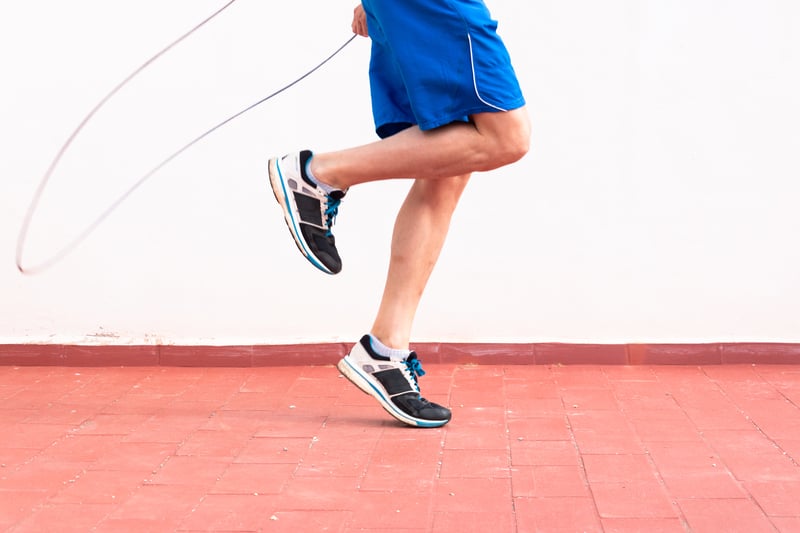Try This Jump Rope Workout for Beginners

Looking for something new to spice up your workouts and increase your level of fun? Try this easy jump rope workout for beginners. You’re sure to love it and get a great workout at the same time.
When Did Jump Ropes Become a Thing?
You may remember jump roping ever since you were a little kid as jumping rope has been around for ages. Jumping has always been a staple in the way we’ve moved, dating all the way back to ancient times. As a functional movement, jumping was necessary to traverse rugged terrain, escape, and hide and attack.
But that’s not all. Jumping rope was recognized as early as 1600 A.D. in Egypt and Australia as a pleasurable activity as people used vines to fashion archaic jump ropes. Jump roping spread across continents and soon became a popular pastime with children.
Eventually, it was realized that this type of activity was also great for conditioning. Jumping rope was adopted by athletes worldwide as a mechanism for increasing speed, agility, strength, and conditioning.
Types of Jump Ropes
Not all jump ropes are created equal. You’ll want to choose one based on your goals.
First, you’ll want to check the length of the rope. As we are all different heights, it makes sense that we need different length ropes. You’ll want to use a jump rope that is about three feet longer than you are tall. For reference, when you step on the center of the rope and bring both sides up, your hands should be about chest level.
Next, decide whether you will want to use a regular jump rope, a weighted rope, or a speed rope. If you’re just starting out, opting for a regular jump rope is a good idea until you learn “the ropes.”
A basic jump rope will be of normal thickness and weight with handles on each end. If you want to get fancy, besides going for soft foam handles, you can choose handles containing ball bearings that will allow the rope to move without obstruction.
If you’re ready to progress, try your hand at a weighted jump rope. Usually, people will choose between 1-, 2-, and 3-pound ropes (or any variation in between). The idea is to create a little extra resistance to build up strength.
And if it’s stamina you’re after, then a speed rope might be for you. A speed rope is lighter, allowing for fast movement and fancy jumping moves.
What are the Benefits of a Jump Rope Workout?
Jumping rope is a great workout that has a lot of benefits. Here are 7 benefits to starting a jump rope workout for beginners.
1. Jumping rope has a huge fun factor. There’s nothing like a little nostalgia from your childhood to make an exercise fun. And if you’re jumping rope with friends, it might just be impossible not to smile and laugh while you’re doing it.
2. It’s a great cardiovascular workout. It might be a lot of fun, but that doesn’t mean your heart rate’s not through the roof. Jumping rope is hard work, and doing it for long periods of time can prove taxing. But, you’ll find that conditioning will come if you keep at it.
3. Great way to burn body fat. Yes, jumping rope is hard, and that’s why it’s such a great fat burner. Jumping rope can burn between 1,000 and 1,300 calories an hour! However, most folks will opt for 5- to 10-minute increments because it is such a tough workout.
4. Super portable. There’s probably no more portable exercise equipment than a jump rope. You can take it anywhere with you and can easily stow it in a purse or backpack. Great for travel or just an extra in your gym bag. You can easily have a jump rope at the ready anytime, anywhere.
5. Build up your bones. Yes, all that jumping and landing helps strengthen your bones and build mass. Keeping your bones strong through impact and weight-bearing exercises is essential as you get older, and jumping rope can help you tremendously.
6. It’s a versatile workout. You can use jumping rope to warm up for your workout or increase the intensity to make it a killer fat-burning workout. Or, use it for conditioning, agility, and stamina. And don’t forget the added benefits of building healthier bones with the resistance jumping rope provides.
7. It’s a full-body workout. If you want to quickly work your entire body, there’s no better way than a jump rope workout. Upper body, lower body, and core all have to participate in this full-body movement.
Try This Jump Rope Workout for Beginners
Decide which rope you’d like to use to start. You may want to just begin this jump rope workout for beginners with the normal, non-weighted rope in the correct length for your height.
1. Basic Jump

Grab a handle in each hand and let the rope hit the ground behind your feet. Stand with feet about hip-width apart. Bring your arms up, slightly back, and then over your head to bring the jump rope up, over your head, and in front of your body. As the rope hits the ground in front of you, jump over it, and continue swinging the rope around your body and jumping over it.
2. Alternate Foot Jumps

For this jump, start with your feet about hip-width apart and bring the rope up and around. However, this time, instead of jumping with both feet, lift your left foot off the ground and jump up with only your right. When the rope comes back around, do the opposite: lift the right foot off the ground and jump up with the left. Continue alternating jumps with each foot.
LIMITED TIME OFFER: Get Ageless Turmeric, Our Highly-Bioavailable Turmeric & Ginger Supplement, As Low As $14
3. Single Foot Jumps

Instead of landing on alternate feet during your jumps, keep your left foot elevated the whole time, only landing on the right for a complete cycle. Then, repeat on the opposite side.
4. Criss-Cross Jumps
This is a little more difficult than your basic jump. For these, you’ll use a cadence (one, two, three). The “one” will be your basic jump, the next revolution of the rope will be “two,” and you’ll bring your right hand over to your left, and “three,” you’ll bring your left hand over to your right for the third time the rope comes around. Continue alternating between basic jump, right to left, left to right, and basic again.
5. Side-to-Side Jumps
Similar to the basic jump, instead of landing in the center when you jump, alternate between landing to your right and landing to your left.
6. High Knee Jumps
You can do these one leg at a time (or both if you have a lot of energy!). Jump as you would with the alternate foot jumps, except bring your knee up high when you jump. Then repeat for the opposite foot.
Now, put it all together:
- 1 minute slow basic jumps (warm-up)
- 30 seconds criss-cross jumps
- 1 minute basic jumps
- 30 seconds high knee jumps
- 1 minute basic jumps
- 30 seconds side-to-side jumps
- 1 minute basic jumps
- 30 seconds single foot jumps (15 seconds each foot)
- 1 minute basic jumps
- 30 seconds alternate foot jumps
Start with this round and then rest. If you’re up for it, repeat the cycle. You can also vary the interval times to increase or decrease the difficulty. Just be prepared for a super intense workout!




 7 Signs Your Body is Seriously Low on Collagen (not just wrinkles)
7 Signs Your Body is Seriously Low on Collagen (not just wrinkles) Health Expert: "Turmeric Doesn't Work (unless...)"
Health Expert: "Turmeric Doesn't Work (unless...)" 3 Warning Signs Your Probiotic Supplement is a Total Waste
3 Warning Signs Your Probiotic Supplement is a Total Waste

